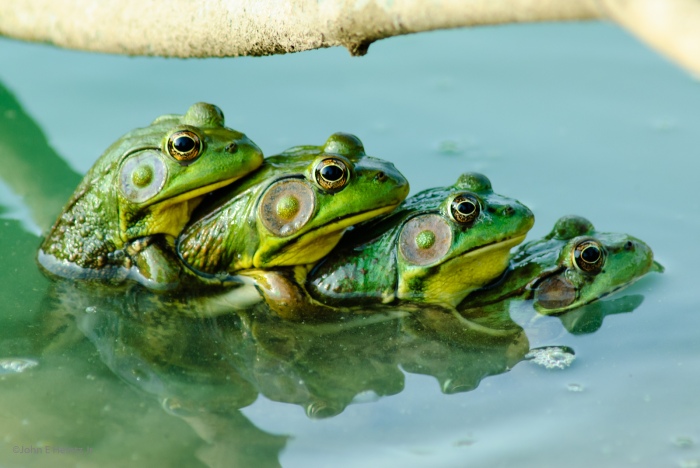BACKYARD NATURE, photo by John E Heintz Jr
April is the time when we start to hear some of Michigan’s 13 species of frogs and toads making noise. While the green frogs pictured above were confusing their Frogbook friends in July, most of the distinctive spring frog calls are males advertising that they’re looking for love. The Michigan frog & toad page from the DNR explains:
As temperatures rise in early spring, frogs begin to move to their breeding sites. The actual timing depends on the warmth of the air and water, and the humidity, but there is noticeable order in which the various Michigan species become active and begin voicing their breeding calls. For example, in southern Michigan the raspy voice of the Western Chorus Frog is usually heard first, often in late March, followed quickly by the highpitched peeps of the Spring Peeper. In a few days the woodland swamps are filled with the quack like calls of the male Wood Frogs, while in another week in open marshes the low snores of the Leopard Frog are barely heard over the squeaky songs of newly arrived Red Winged Blackbirds.
The first warm rains of April bring American Toads out of the woods to the breeding ponds, where the air is soon filled with their melodious trills. Several of our frogs postpone their breeding activities until later in spring, when air and water temperatures are higher. Included in this late group are the Gray Tree Frog, Blanchard’s Cricket Frog, and Green and Bull Frogs.
Frogs are far more often heard than seen. Most frog sounds are the advertisement calls of the males, intended to attract the females for breeding. Frog voices may carry for long distances, especially the higher pitched calls of the smaller species. The males increase the loudness of their calls by ballooning out their throats or special sacs at the sides of their throats, creating a kind of resonating chamber. Only males produce advertisement calls, but both sexes may give shorter warning calls or screams when danger threatens. Males can also produce distinct calls that warn away rival males that approach their calling or breeding sites.
Female frogs and toads may lay hundreds or even thousands of eggs. These are usually attached to underwater vegetation or left floating in large masses at the surface. During egg laying, the male clings to the female’s back and fertilizes the eggs. The small, dark eggs are protected by layers of a jelly like substance. They may be in rounded masses (as in Wood and Leopard Frogs), loose clusters (Gray Tree Frogs), long necklace like strings (Toads), thin surface films (Bull and Green Frogs), or deposited singly or in small clusters (Spring Peeper). Many frog eggs are eaten by predators such as fish, turtles, and aquatic insects, or are lost to drying or destruction by micro organisms.
Read on for more and also read more about the frog life cycle from All About Frogs.
Check this out on black and see more in John’s BACKYARD NATURE slideshow.
More frogs & toads and more of our “Best Friends in Nature” series on Michigan in Pictures!


One thought on “Frog Sex: It’s Complicated”